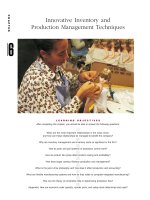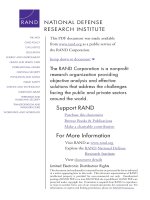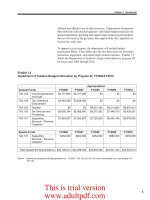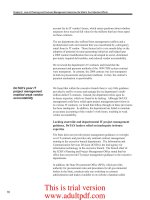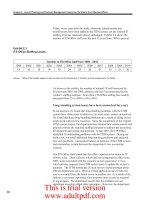Lecture Principle of inventory and material management - Lecture 11
Bạn đang xem bản rút gọn của tài liệu. Xem và tải ngay bản đầy đủ của tài liệu tại đây (759.96 KB, 45 trang )
Lecture 11
Capacity Management and Planning
Books
•
Introduction to Materials Management, Sixth Edition, J. R. Tony Arnold, P.E., CFPIM, CIRM, Fleming
College, Emeritus, Stephen N. Chapman, Ph.D., CFPIM, North Carolina State University, Lloyd M.
Clive, P.E., CFPIM, Fleming College
•
Operations Management for Competitive Advantage, 11th Edition, by Chase, Jacobs, and Aquilano, 2005,
N.Y.: McGrawHill/Irwin.
•
Operations Management, 11/E, Jay Heizer, Texas Lutheran University, Barry Render, Graduate School of
Business, Rollins College, Prentice Hall
Objectives
•
•
•
•
•
•
Capacity
Capacity Management
Matching Capacity and Demand
Capacity Planning process
Resource Planning
Inputs to capacity planning
Capacity
•
•
•
•
The throughput, or the number of units a
facility can hold, receive, store, or produce
in a period of time
Determines
fixed costs
Determines if
demand will
be satisfied
Three time horizons
Capacity Management
•
Capacity management is planning and controlling
resources needed to meet production objectives
– Planning determining resources needed to meet the
priority plan; selecting methods to make that capacity
available
– Controlling monitoring output, comparing it with the
plan, and taking corrective action
Matching Capacity and Demand
•
Demand Management
–
–
–
•
vary prices
change lead times
encourage/discourage business
Capacity Management
–
–
–
–
adjust staffing
adjust equipment and processes
change methods to facilitate production
redesign the product to facilitate production
Capacity Planning Process
•
•
•
•
Determine the capacity available at each work center.
Translate the released and planned orders into the
capacity required at each work center in each time
period.
Sum up the capacities required for each work center to
determine the load on each work center in each time
period.
Resolve differences between available capacity and
required capacity.
Planning Over a Time Horizon
Long-range
planning
Intermediaterange
planning
Add facilities
Add long lead time equipment
*
Subcontract
Add equipment
Add shifts
Short-range
planning
*
Modify capacity
* Limited options exist
Add personnel
Build or use inventory
Schedule jobs
Schedule personnel
Allocate machinery
Use capacity
Resource Planning
•
•
•
RP involves longrange capacity resource
requirements and is directly linked to production
planning.
RP involves changes in manpower, capital
equipment, product design, or other facilities that
take a long time to acquire and eliminate.
The production plan and RP set the limits and
levels for production.
RoughCut Capacity Planning
RCCP is the process to check the feasibility of the master
production schedule (MPS) (end items), provide warnings of
any bottlenecks, ensure utilization of work centers, and
advise vendors of capacity requirements.
Capacity Requirements Planning
•
•
CRP is directly linked to the material requirements plan
(MRP) (component items).
CRP is the most detailed, complete, and accurate of the
capacity planning techniques and is highly important in the
immediate time periods.
Inputs for Capacity Planning
•
Inputs needed are:
–
–
–
–
open shop orders from open order file
planned order releases from material
requirements plan
routings and time standards from the routing file
lead times and work center capacities from the
work center file
Inputs for Capacity Planning
•
Planned order releases are determined by the computer’s
MRP logic based upon the gross requirements for a
particular part. Used to help assess the total capacity
required in future time periods.
Inputs for Capacity Planning
•
Routing file is the path that work follows from work
center to work center as it is completed. It should
contain:
–
–
–
–
–
–
Operations to be performed
Sequence of operations
Work centers to be used
Possible alternate work centers
Tooling needed for each operation
Standard times: setup times and run times per piece
Inputs for Capacity Planning
•
Work center file is composed of a number of machines or
workers capable of doing the same work. It contains the
following information
–
–
–
–
Move time is the time normally taken to move material from
one workstation to another.
Wait time is the time a job is at a work center after completion
and before being moved.
Queue time is the time a job waits at a work center before
being handled.
Lead time is the sum of queue, setup, run, wait, and move
times.
Determining Capacity Available
•
What is Capacity available?
– The capability of a system or resource to produce a
quantity of output in a particular time period.
APICS Dictionary
Determining Capacity Available
•
How do we calculate Capacity?
– To calculate available capacity, we need to know:
•
Available time
•
Utilization
•
Efficiency
Available Time
Available time depends on the number of
machines, the number of workers, and the hours of
operation. The number of hours a work center can
be used.
If a work center has three equivalent machines and
works eight hours a day for five days a week, what is
its weekly available time?
Available time = 3 x 8 x 5 = 120 hours per week
•
Utilization
•
Utilization is the percentage of time that the work
center is actually active.
Hours actually worked
Utilization =
x 100%
Available hours
What is the utilization if a work center is available for
120 hours a week, but produces goods for only 100
hours?
100
Utilization =
x 100% = 83.3%
120
Efficiency
Standard Time is the time it would take a qualified
operator working at a normal pace to do the job using the
proscribed method.
Efficiency
•
Efficiency is a measure (as a percentage) of the actual
output compared with the standard expected output.
Standard hours of work
Efficiency =
x 100%
Hours actually worked
What is the efficiency if a work center is used 100 hours
per week and produces 120 standard hours of work?
120
Efficiency =
x 100% = 120%
100
Utilization and Efficiency Problem
A work center produces 90 standard hours of work in one
week. The hours available are 80, and 70 are actually
worked. Calculate the utilization and efficiency of the work
center.
70
Utilization =
x 100% = 87.5%
80
90
Efficiency = x 100% = 128.57%
70
Rated Capacity
•
Rated capacity is a measure of the output that can be
expected for a work center.
Rated Capacity = available time x utilization x efficiency
A work center has 3 machines and is operated 8 hours a
day for 5 days/week. Past utilization has been 75% &
efficiency has been 110%. What is the rated capacity?
Available time = 3 x 8 x 5 = 120 hours per week
Rated capacity = 120 x 0.75 x 1.10 = 99 standard hours
Rated Capacity Problem
A work center consists of six machines that are available 16
hours per day for five days a week. Utilization is 80%, and
efficiency is 120%. What is the rated weekly capacity?
Rated Capacity Problem
Available time = 6 x 16 x 5
= 480 hours per week
Rated capacity = 480 x 0.80 x 1.20
= 460.8 standard hours
Demonstrated (Measured) Capacity
•
Demonstrated capacity is proven capacity
calculated from actual performance data. The
result is average capacity.
Over the previous four weeks, a work center
produced 110, 140, 120, and 130 standard hours of
work. What is the demonstrated capacity?
110 + 140 + 120 + 130
Demonstrated capacity =
4
125 standard hours
